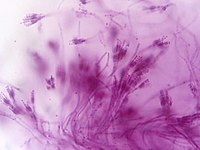
Photo from wikipedia
Ochratoxin A (OTA) is one of the worldwide most important mycotoxins in terms of health and agroeconomic consequences. With the aim to promote the use of phytochemicals as alternatives to… Click to show full abstract
Ochratoxin A (OTA) is one of the worldwide most important mycotoxins in terms of health and agroeconomic consequences. With the aim to promote the use of phytochemicals as alternatives to synthetic fungicides, the effect of hydroxycinnamic acids on the fungal growth and OTA yield by two major OTA-producing species was investigated. After a first step dedicated to the definition of most suitable culture conditions, the impact of 0.5 mM ferulic (FER), p-coumaric (COUM), caffeic and chlorogenic acids was evaluated on Aspergillus westerdijkiae and Penicillium verrucosum. Whereas no fungal growth reduction was observed regardless of the phenolic acid and fungal isolate, our results demonstrated the capacity of FER and COUM to inhibit OTA production. The most efficient compound was FER that led to a 70% reduction of OTA yielded by P. verrucosum and, although not statistically significant, a 35% inhibition of OTA produced by A. westerdijkiae. To further investigate the bioactivity of FER and COUM, their metabolic fate was characterized in fungal broths. The capacity of P. verrucosum to metabolize FER and COUM through a C2-clivage type degradation was demonstrated. Overall, our data support the potential use of FER to prevent OTA contamination and reduce the use of synthetic pesticides.
Journal Title: International Journal of Molecular Sciences
Year Published: 2020
Link to full text (if available)
Share on Social Media: Sign Up to like & get
recommendations!